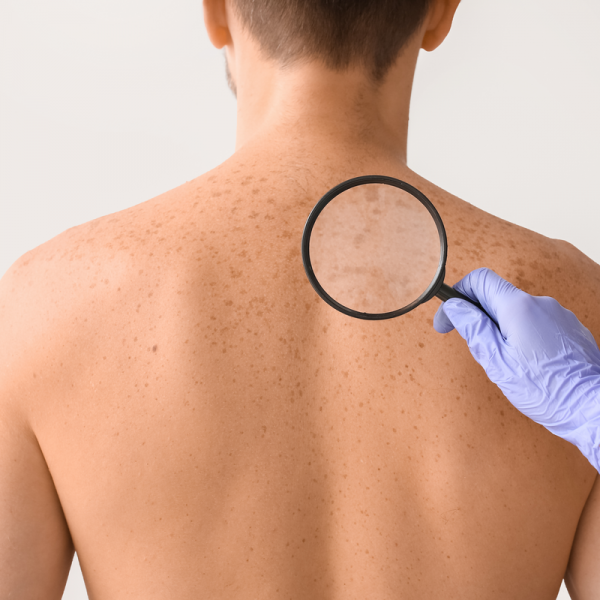
What is white skin cancer?
White or light skin cancer is the most common type of skin cancer. White skin cancer is divided into basal cell cancer (basal cell carcinoma) and spinalioma (squamous cell carcinoma), the so-called prickle cancer, whereby basal cell cancer occurs much more often.
Both types of cancer grow rather slowly and rarely form metastases.
How does basal cell carcinoma develop?
Basal cell carcinoma develops from the root sheaths of the hair follicles and the cells of the lowest layer of the epidermis (basal cell layer). Although between 70 and 80 percent of all basal cell carcinomas occur mainly in the head and neck area, it can in principle develop all over the body. Particularly affected are the parts of the skin that are exposed to the sun a lot, such as the lip, nose or forehead. But basal cell carcinomas also often form on the neck and hands. It is less common on the legs. Basal cell carcinoma affects women and men about equally often. Many patients develop this cancer around the age of 60, although it can also occur at a younger age.
How can basal cell carcinoma be prevented?
Skin cancer is usually caused by intense UV radiation. To prevent basal cell carcinoma, the skin should be covered with the right UV protection before sunbathing and appropriate clothing should be worn. In addition, direct sunlight should be avoided, especially during the summer midday hours, as well as regular visits to a solarium. These precautions are especially recommended for people with a fair skin type, as they have an increased risk of developing skin cancer.
What are the symptoms of basal cell carcinoma?
Basal cell carcinoma can initially take on the appearance of a waxy, skin-coloured to reddish nodular tumour with an often pearly fringe (nodular basal cell carcinoma). It is also not uncommon for nodular basal cell carcinoma to bleed every now and then. Besides nodular basal cell carcinoma, there are other subtypes. Some of them can take on the appearance of scar tissue or be red or darkly pigmented.
How is basal cell cancer treated?
The doctor will try to remove the basal cell cancer completely, including the hem. If the tumour is too large or has grown too deep into the tissue, surgery is usually not possible. In this case, other treatment options are used, such as radiation therapy or cryotherapy. The latter involves freezing the tumour with liquid nitrogen. However, it is also possible to treat the tumour with the active substance Imiquimod, a so-called immune modulator, which is supposed to stimulate the immune system to fight off the tumour cells. This external treatment by means of a cream is mainly carried out if it is a large, superficial basal cell cancer. In addition, a special light treatment (photodynamic therapy) is also possible. In this case, the tumour is first made light-sensitive with a special cream and then irradiated with intensive light.
What is the prognosis for basal cell carcinoma?
Because basal cell carcinoma rarely forms metastases, this cancer is also called semi-malignant by doctors. If basal cell carcinoma is diagnosed early, it can be cured in about 95 percent of all cases. Complete surgical removal of the tumour is always the most promising treatment method. However, even after successful treatment, the patient should attend regular follow-up examinations, as approximately four out of ten affected people develop basal cell carcinoma again after the first three years of diagnosis. Only about one in 1,000 patients die from basal cell carcinoma.
How does a spinalioma develop?
Spinalioma, the so-called prickle cell cancer, is the second most common form of white skin cancer after basal cell carcinoma. On average, men develop spinalioma slightly more often than women. People around the age of 70 are particularly at risk. A spinalioma is a squamous cell carcinoma. It develops from the squamous cells (keratinocytes), the important structure-giving cells of the epidermis, and grows quite aggressively. If a spinalioma is not treated, it also destroys the surrounding healthy skin tissue over time and, in an advanced stage, also tends to metastasise to other parts of the body. Early treatment is therefore all the more important.
What risk factors can trigger spinalioma?
Similar to basal cell carcinoma, spinalioma can also be caused by intensive UV radiation. In addition, certain toxins such as arsenic, tar or soot are also considered risk factors for spinalioma. Since the tongue and mouth area in particular are damaged by chronic alcohol and tobacco consumption, spinalioma can also spread here.
What are the symptoms of spinalioma?
A spinalioma usually manifests itself by its reddened and scaly appearance, which can usually be accompanied by a brownish-yellowish skin change. In some patients, a spinalioma may also be a scabby or crusted sore that occasionally bleeds. Similar to basal cell cancer, spinalioma also forms on areas of the skin that are exposed to intense UV radiation, such as the forehead, nose, ears, back of the neck or back of the hands.
How is a spinalioma treated?
In the case of spinalioma, the doctor will also try to remove the tumour completely by surgery. If this is not possible because of the size of the tumour or the stage of the cancer, other forms of treatment can be used. These include cryotherapy (freezing the tumour cells) or local chemotherapy, radiotherapy or immunotherapy.
What is the prognosis for spinalioma?
If the spinalioma is not larger than one centimetre when it is diagnosed and has not spread to other parts of the body, the patient has an almost 100% chance of being completely cured. If, on the other hand, the spinalioma has already metastasised, the prognosis worsens. If there is also immunosuppression, i.e. the patient's immune system is suppressed due to an HIV infection, for example, the cancer progresses even more aggressively. On average, between 40 and 50 out of every 1,000 patients die of spinalioma.
